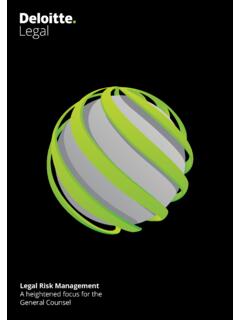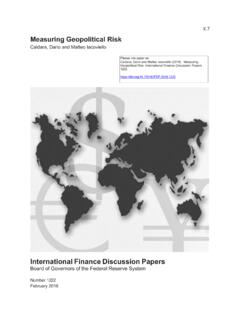Transcription of RISK COMMUNICATION & COMMUNITY ENGAGEMENT …
1 COVID-19 preparedness & responseRISK COMMUNICATION & COMMUNITY ENGAGEMENT (RCCE) ACTION PLAN GUIDANCE Risk COMMUNICATION and COMMUNITY ENGAGEMENT (RCCE) is an essential component of your health emergency preparedness and response action tool is designed to support risk COMMUNICATION , COMMUNITY ENGAGEMENT staff and responders working with national health authorities, and other partners to develop, implement and monitor an effective action plan for communicating effectively with the public, engaging with communities, local partners and other stakeholders to help prepare and protect individuals.
2 Families and the public s health during early response to guidance can be used to develop an RCCE plan that, once completed, will constitute a basic evidencebased source for engaging and communicating effectively with identified audiences. The resulting plan will facilitate effective RCCE, two-way COMMUNICATION between health authorities and at-risk populations in response to COVID-19. It includes planning for ENGAGEMENT with and within local at-risk communities, broader segments of the public at the country-level, and other relevant stakeholders (such as health care providers).
3 There are 3 sections to the RCCE action plan guidance: 1. The Key Steps to developing a COVID-19 RCCE plan. 2. A related planning template for countries to fill in related to each step. 3. Seven annexes provide additional guidance and resources: an audience assessment questionnaire, a process for identifying objectives and audiences, a method for identifying key information needs about COVID-19, and a list of sources for existing content and messaging. Adapt the elements according to your country needs and situation.
4 Some elements of the action plan guidance may differ between countries, depending upon their risk levels, people s perceptions, needs, local capacities and current situations. RCCE ACTION PLAN GUIDANCE | COVID-19 PREPAREDNESS AND RESPONSE2 |Key considerationsObjectiveHow to use this toolCOVID-19 preparedness and responseRCCE ACTION PLAN GUIDANCERCCE ACTION PLAN GUIDANCE | COVID-19 PREPAREDNESS AND RESPONSE3 | Revise your action plan according to the situation evolution. Note that your objectives and priorities may change over time depending on the evolution of COVID-19 outbreak (epidemiology) and people s reactions to the response.
5 Coordinate and plan together with authorities and partners. To strengthen your preparedness, ensure effectiveness, and avoid duplication, it is important from the start to identify, meet, plan and coordinate with your partners, existing COMMUNITY networks and government counterparts. Remember that communities should play a major role as implementers and leaders in promoting individual and collective behaviour change to prevent and respond to COVID-19. Proactively communicate and promote a two-way dialogue with communities, the public and other stakeholders in order to understand risk perceptions, behaviours and existing barriers, specific needs, knowledge gaps and provide the identified communities/groups with accurate information tailored to their circumstances.
6 People have the right to be informed about and understand the health risks that they and their loved ones face. They also have the right to actively participate in the response process. Dialogue must be established with affected populations from the beginning. Make sure that this happens through diverse channels, at all levels and throughout the response. Reduce stigma. Regular and proactive COMMUNICATION with the public and at-risk populations can help to reduce stigma, build trust and increase social support and access to basic needs for affected people and their families.
7 Stigma can undermine social cohesion and prompt social isolation of groups, which might contribute to a situation where the virus is more, not less, likely to spread. Accurate information can help alleviate confusion and avoid misunderstandings. The language used in describing the outbreak, its origins, and prevention steps can reduce stigma. See WHO s Guide to preventing and addressing social stigma for more tips ( ). Conduct early and ongoing assessments to identify essential information about at-risk populations and other stakeholders (their perception, knowledge, preferred and accessible COMMUNICATION channels, existing barriers that prevent people to uptake the promoted ) to develop your plan.
8 Do not assume or take for granted local understandings and perceptions. Qualitative methods such as focus groups and interviews can produce rich, contextual information from a few people. Quantitative methods such as internet or telephone surveys can help characterize larger numbers of people, but with less context. Both approaches can help you systematically ask relevant questions that will shape your intervention strategy. As the threat of COVID-19 evolves, people s knowledge and beliefs will change, so assessments will need to be ongoing to ensure that interventions remain relevant to people at-risk.
9 Ensure that all people at-risk of acquiring COVID-19 are identified, reached and involved. RCCE ACTION PLAN GUIDANCE | COVID-19 PREPAREDNESS AND RESPONSE4 |Define Define and prioritize your key RCCE objectives with your team and partners. Review them regularly to ensure they are responding to your priorities as COVID-19 annex 2 for example of key audiences and influencers Identify target audiences and key influencers. These include policy-makers, influential bloggers or other social media leaders, local leaders, women and youth groups, religious and elders groups, local and international NGOs health experts and practitioners, volunteers, and people who have real-life experience with COVID-19 (those who have had COVID-19 or their family members have contracted the virus).
10 Match audiences and influencers with channels and partners that reach them. See annex 3 for questions to guide you on identifying your RCCE strategy Based on the qualitative analysis results, your defined key objectives and audiences, develop an RCCE strategy that fits into the country s comprehensive COVID-19 response strategy. Adapt to the local context: focus on messages that are tailored to the relevant national and local context, reflecting key audience questions, perceptions, beliefs and practices. Define and prioritize your strategic objectives with your team and partners in alignment with the general objectives of the country s COVID-19 response.












